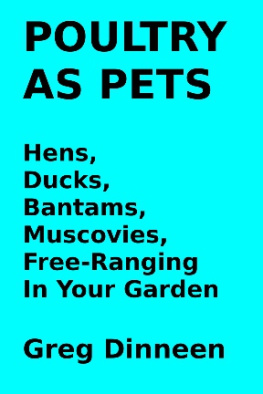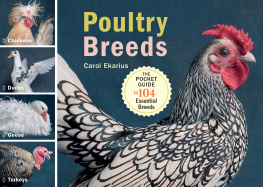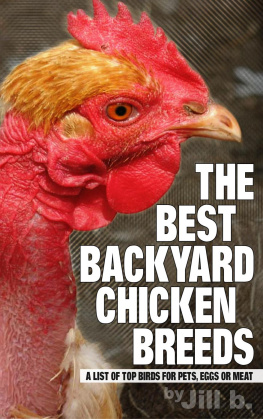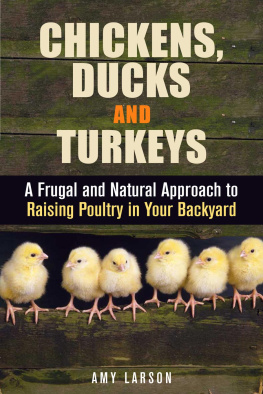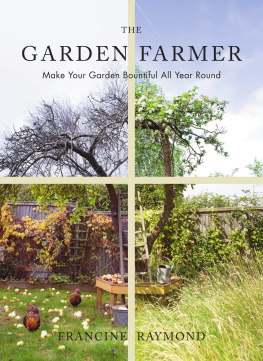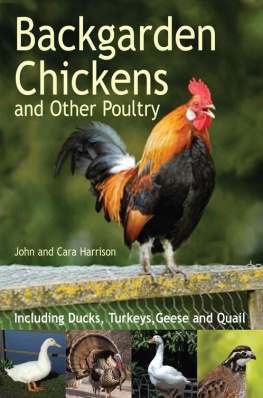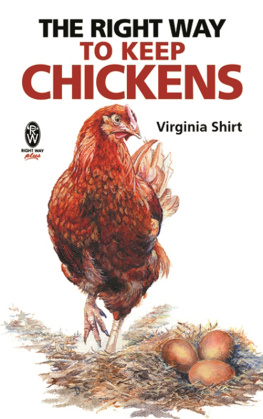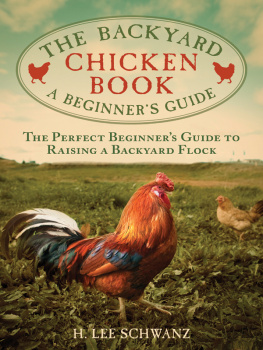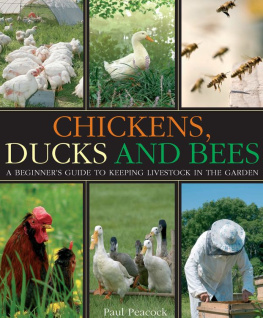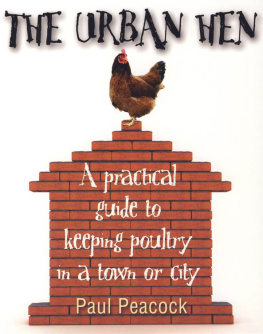TITLE PAGE
POULTRY AS PETSHens, Ducks, Bantams, Muscovies,Free-Ranging In Your Garden Copyright 1983, Greg Dinneen. This Edition Copyright 2015, Greg Dinneen.
All Rights Reserved. Written and Published by Greg Dinneen. Distributed by Smashwords. ISBN: 9781310251887 Email: For more of my eBooks please see my Smashwords Profile at: https://www.smashwords.com/profile/view/LactoVegan You can also Download Free PDFs, of some my pamphlets, from: https://sites.google.com/site/vegetarianinformationcenter My Blog: http://www.lacto-ovo-vegan.blogspot.com
DISCLAIMER
Information in this ebook, is my personal opinion based on my personal experience, which includes my having had poultry as pets, including hens, bantams, ducks and Muscovies. Information in this ebook, is not to be taken as professional advice.
Or, as a substitute for professional advice.
WELCOME TO POULTRY AS PETS
This book is about pet poultry. Pet poultry, free-poultry, free-ranging in your garden. You might have poultry. You might want to learn about poultry before getting poultry. Or, you might want to give this ebook to someone you know.
I wrote this ebook, because most books on Backyard Poultry, that I have seen, are about exploiting, caging and killing poultry. My ebook is not about teaching people to keep poultry in cages and coops. Often, under worse conditions, than some commercial poultry. My ebook is not about teaching people to kill and eat their pets. My ebook is for people who love their poultry as pets. Who enjoy poultry free-ranging in their gardens.
Not locked up in cages or coops.
POULTRY FREE-RANGING IN YOUR GARDEN
HENS AND BANTAMS If you have a back yard, of at least 2000 square feet, 200 m2, you have enough space 2 hens or bantams free-ranging in your back yard. But, ask the gardener in your family first. Bantams are smaller and less destructive than hens. Hens and bantams only need water to drink. But ducks and Muscovies are water-fowl.
And, so they need a pond to be happy. Roosters do not lay eggs. Roosters just make a lot of noise, very early in the morning, that can be very annoying for your neighbours.
POULTRY-PROOF PLANTS FOR A POULTRY-PROOF GARDEN
Many plants are poultry-proof. FRUIT AND NUT TREES In my area, almonds, apples, apricots, cherries, figs, feijoas, loquats, plums and tamarillos, grow very easily. And, once established, are poultry-proof.
Indeed, my hens used to sleep in one of my fig trees. And a combination of apples, feijoas, figs, loquats, raspberries and tamarillos can provide fruit all year. In warm areas oranges and mandarins can provide fruit all year. HERBS And, a pretty herb garden can be planted so that you can see it through your kitchen window. FLOWERS Flowers such as tree dahlias, jonquils, daffodils, agapanthus, gladioli, roses. Rhubarb and asparagus are easy to grow perennials.
So are many herbs such as Aloe Vera and mints. EASY PLANTS Just plant the easiest plants. And, forget about it. Bulbs, succulents, herbs and flowers that like dry conditions. Mints in damp parts of your garden. Some fruit or nut trees.
And, some shrubs like camellias. TREES AND SHRUBS FOR PERCHING My hens slept in one of my fig trees during the summer. During the winter, when my fig trees had lost their leaves, my hens slept in my camellia bush.
DO YOU REALLY WANT POULTRY?
Hens can live 9 years. Ducks for 20 years. Will you want to look after your poultry 10 years from now? Or, even 6 months from now? If not then buy a cuddly toy and a computer for entertainment.
My hens, bantams, ducks and Muscovies had free access to all of my garden. They were never caged. If you are just going to keep your hens locked-up in a cage or small run in your garden. You may as well buy genuine free-range eggs. But, check that they are genuine free-range eggs. WHAT TYPE? If you want beauty then choose poultry you like the look of. WHAT TYPE? If you want beauty then choose poultry you like the look of.
If you want a lot of eggs: Choose egg-laying rescue hens. Not the meat-hens. Or pure-bred egg-laying breeds. Such as White Leghorn, Black Australorpe or Rhode Island Red hens. FULL SIZE OR BANTAMS? If you want eggs then full size egg-laying breeds. Otherwise bantams.
So that your yard looks 4 times bigger to them. COST OF FOOD If you have a large grassed yard, of at least 100 m2 per hen, then all you might need to give them could be 50 to 100 grams of seeds, such as wheat, rye, rice, lentils, per day. And, any of your leftover food.
LOOKING AFTER POULTRY AS PETS
POULTRY NEED FOOD, WATER, SHELTER, SPACE, COMPANY,... Hens are generally easier to look after than ducks. Hens live about 9 years and ducks about 20 years.
If you want birds for pets then you could get yourself a couple of hens or bantams. And let them loose in your back yard. Rather than lock some poor canary or budgerigar up in some little cage. EGGS If you want pure bred birds for eggs then buy top quality White Leghorn, Black Australorpe, Rhode Island Red hens or Khaki Campbell ducks. Or, provide a good home for rescued battery hens. They can lay 300 eggs per year when they are young.
And, fewer but larger eggs as they get older. NOISE Roosters do not lay eggs. Just make a lot of noise. Enough to wake you, and your neighbours, at dawn. SPACE At least 100 m per hen or duck. Bantams at least 25 m.
In addition to this, ducks need a pond, with at least 2 m of surface area of water per duck, some of which needs to be at least 50 cm feet deep, so that they can swim underwater and so wash themselves. SHADE Shrubs and trees can provide cool shade. Make sure that there is shade all day. Shady shrubs on both the east and west sides of your yard. And, some areas of sunshine.
SLEEPING
Hens and bantams sleep at night.
They like to perch in a tree or a shrub or in a shed. Hens and bantams do not mind being locked up all night, in a shed, since all that they do is sleep. So if you have to lock your poultry up at night, to protect them from foxes or other predators, then have hens or bantams. Ducks feed at night, as well as in the daytime, and so they do not like to be locked up at night. Hens and bantams like to perch. Ducks will either sleep on the ground or floating on the water.
In my suburban backyard, my ducks slept under shrubs during the day, and on their pond at night. My hens slept in a fig tree in summer; a camellia bush in winter. My bantams on a windowsill. They were never locked up. SHELTER Shrubs, trees and fences can provide sufficient shelter from wind and sun and rain for ducks.
COMPANY
Birds naturally live in flocks.
COMPANY
Birds naturally live in flocks.
Except when they were sitting on nests of eggs my ducks and hens and bantams were always together. They slept together; they ate together; walked around together; and, the ducks bathed together. And, whenever one of them got separated she called out to the others and they called back to her so they could get back together. Always have at least 2 hens or 2 bantams or 2 ducks for company. Preferably get them together, or at the same time, to prevent possible fights over territory.
WATER
Hens and bantams are descended from jungle fowl and only need water to drink.
To bathe, hens and bantams have dust baths in dry garden soil. However, ducks are water fowl. Ducks need water to eat with and swim and wash themselves in. Ducks naturally live in lakes and rivers and are adapted to those conditions. So ducks need, shade and water, as well as sunshine. DUCK PONDS Ducks need a pond to wash themselves in.

